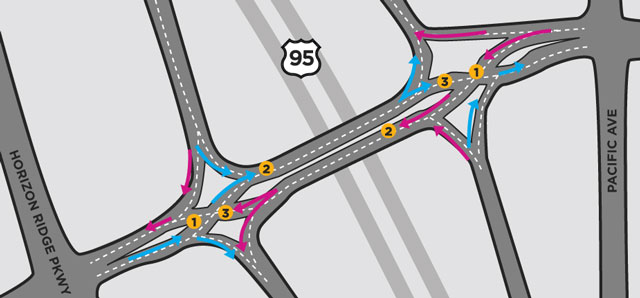Monday, Jan. 26, 2015 | 2 a.m.
Get ready to feel like you’re driving in Europe.
A newly designed highway interchange that opened this week at Horizon Drive and U.S. 95 in Henderson temporarily routes drivers to the left side of an overpass bridge.
Why? State Department of Transportation officials say “diverging diamond interchanges” improve traffic flow and increase safety for motorists, bicyclists and pedestrians because vehicles avoid making left turns that cross opposing traffic.
Henderson officials chose Horizon Drive for the interchange because of the location’s high volume of traffic. About 30,000 vehicles drive through the interchange each day, Henderson spokesman Keith Paul said.
Traffic often backed up to block Horizon Ridge Parkway in the mornings and Horizon Drive in the evenings, in part because of a tangle of traffic signals within a few hundred feet of one another and in part because of a succession of left turns across traffic.
Diverging diamond interchanges can handle up to 650 left turns per hour, about twice the number of a conventional interchange. The city began planning the project in April 2013.
How it works

1. Vehicles entering the interchange from either direction on Horizon Drive curve slightly to the left and hit a traffic light. The signal allows motorists to safely cross over to the left side of the road on the freeway bridge.
2. Once on the left side, drivers can turn onto the highway without stopping or crossing opposite traffic.
3. Motorists continuing across Horizon Drive hit a second traffic light near the end of the interchange, which directs them back to the right side of the road.
* The interchange also features dedicated bike lanes to the right of the road. Bicyclists must obey the same traffic signals as drivers.
A center median protects bicyclists from oncoming traffic. There’s also new green striping to raise motorists’ awareness of riders.
The design includes sidewalks and typical crosswalks at the intersections.
How common is the design?
Nineteen states, including Nevada, have diverging diamond interchanges, and many have multiple diverging diamonds. Every other state except Hawaii, North Dakota, New Jersey, Connecticut and New Hampshire is planning or in the process of building one or more such interchanges.
Gilbert Chlewicki, who designed diverging diamond interchanges, says they’re gaining in popularity for three main reasons: They move traffic faster, lead to fewer crashes and are more cost efficient.
“They are tremendously less expensive than most alternatives,” he said.
For instance, a diverging diamond interchange in Springfield, Mo., cost $3.2 million. An alternative design would have cost more than $10 million, according to Chlewicki.
The Horizon Drive interchange will be the first diverging diamond interchange in Southern Nevada. The only other in Nevada is at Interstate 580 and Moana Lane in Reno. It opened in November 2012.
Before 2009, the only diverging diamond interchanges were in France. They first were built there in the 1970s.
How diverging diamonds improve efficiency
Traffic signals in diverging diamond interchanges have no turn arrows; they change only from green to yellow to red, then back to green. That means no waiting for vehicles to turn.
The length of red lights also is shorter — about one minute, versus the typical two. That also helps reduce delays and congestion.
A nationwide analysis of diverging diamond interchanges found they reduced intersection travel time by nearly 40 percent and decreased crashes by 50 percent.
What are the benefits?
• Fewer areas prone to crashes
• Better visibility for turning
• Less driver confusion once people become familiar with the setup
• Shorter pedestrian crossings
• Makes wrong-way entry to highway ramps extremely difficult
What are the shortcomings?
• They can be confusing for drivers unfamiliar with the design
• Off-ramp traffic can’t re-enter the highway, meaning long detours if someone takes the wrong exit or gets lost, is carrying an oversized load or is rerouted because of a crash
• Motorists exiting the highway must yield to oncoming traffic because vehicles could be approaching from the far left lanes, not the expected nearest lanes
• Pedestrians might be confused at crosswalks by traffic coming from an unexpected direction
• Bus stops typically are built outside the interchange
Sources: Nevada Department of Transportation, divergingdiamond.com

Join the Discussion:
Check this out for a full explanation of our conversion to the LiveFyre commenting system and instructions on how to sign up for an account.
Full comments policy